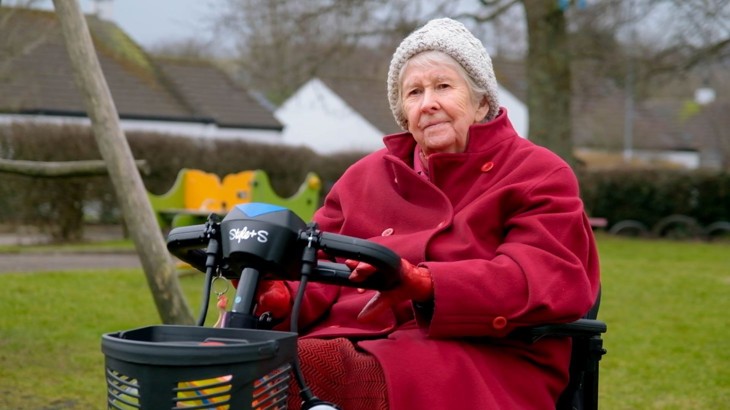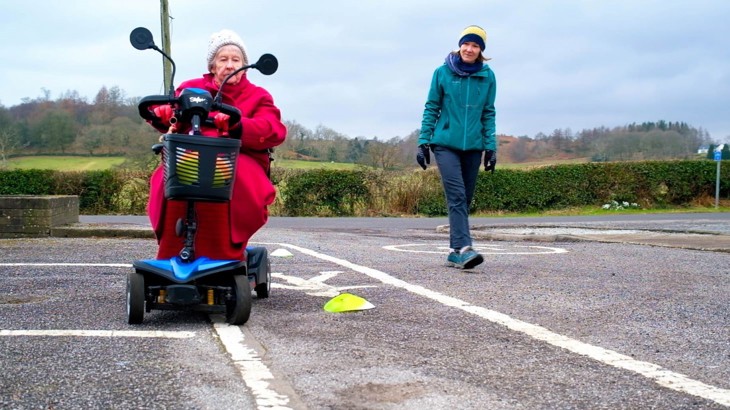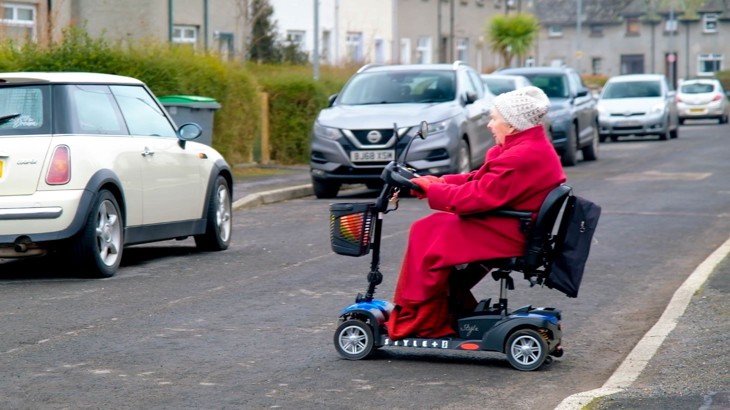Sustrans’ IBike Communities team works with adults to increase their levels of active travel and physical activity. We met Pat from Dumfries and Galloway, to hear how the programme is helping her use a mobility scooter for more of her everyday journeys.
Pat has been living in a small town in rural Dumfries and Galloway since 1971.
After being gifted a mobility scooter by a friend but nervous about learning how to use it, Pat was put in touch with her local IBike Communities Coordinator, Annick Laroque.
Together they have been working to improve her confidence on the paths, as well as pushing for wider accessibility improvements within the community.
This is their story.
Combatting isolation
Pat has arthritis and osteoporosis and gets walking as much as she can.
She wanted to learn how to use the scooter for when walking isn’t an option for her.
“I am in my 80s and living alone. It can be very lonely and isolating at times.
“While I still walk, it's good to be able to go up to the shops or have coffee with friends on the scooter”.

Pat's mobility scooter helps her get out and about in town and meet with friends.
Getting comfortable using a mobility scooter
After being referred by another member of the community, Pat began doing regular sessions with Annick to help build her confidence.
“The first day I met her at the house I actually helped to switch it [the scooter] on and get it out the house, because getting in and out is a challenge in itself”, Annick remembers.
“Then, we started by working out Pat’s goals - where she’d like to go now and in the future.
“Each week we chose a different destination and worked out how to get there, as well as how not to get there.
“It took us a long time to travel anywhere at first, so we also started working with cones to do skills training – including three-point turns, turning in a tight circle, and working out strategies for getting out of a pickle.”
Pat describes these sessions as “very, very useful”.
“They've taught me how to turn and helped when I come to a drop [in the pavement]. I have also utterly enjoyed them – it’s been good fun”, she adds.

Pat worked with Annick on skills training, to build her confidence using the mobility scooter.
Accessibility challenges
As Pat and Annick spent more time travelling around the town, there were a number of barriers which impacted their journeys.
“Quite often it’s impossible to reach where we want to go on a scooter because it’s so difficult to actually get on and off the pavements; as they are so uneven”, Annick explains.
“Getting from my house to the main road is really quite difficult”, Pat adds.
“It’s not easy for scooters, prams or wheelchairs. There’s a care home at the bottom of the town, and we used to get a lot of wheelchairs around there, but they've cut back. Possibly because of the weather, but also because the pavements are not good."

Improved surfaces and dropped kerbs would make Pat's local area much more accessible.
Annick explains how living in rural communities can be isolating, but the ability to walk, wheel and cycle helps combat this.
“In places like this, public transport connections aren’t always that great. Many people don't drive or own cars.
“So, having access to bikes and scooters helps for getting about – whether that’s trips to the doctors, the shops, the chemist.”
However, to ensure everyone, regardless of age and ability, is able to travel actively, safe and accessible routes must be put in place.
Pat and Annick are now working to raise awareness of these obstacles locally in a bid to improve the pavements and path links in town.
They have met with the local councillor to discuss the issues Pat faces, such as cambers on pavements, potholes, uneven areas and placement of drains.
Solutions as simple as installing a few more dropped kerbs could make local journeys significantly more accessible for those with limited mobility, like Pat.
Improving health and wellbeing in Dumfries and Galloway
Annick’s work with Pat is part of a wider commitment to improving the health and wellbeing of communities across Dumfries and Galloway.
Having built a relationship with Public Health Scotland and the NHS, the IBike Communities programme is a social prescribing option for active travel.
“Generally, I work with people that have quite complex health needs. Some people can't walk without the aid of a stick or walking aid, but we manage to get them on a bike, trike or scooter.
“The referrals come through home teams – this could be occupational therapists, physiotherapists, mental health support services or the GP.
“If someone's referred to me, I meet up with them and we tailor a program directly to suit the needs of the individual – this typically lasts between 8 to 16 weeks”.

The IBike Communities programme has helped many people like Pat to rebuild their confidence and find the joy in getting outside and getting active.
A partnership approach
IBike Communities focused on building local partnerships to enhance opportunities for increased walking, wheeling and cycling – improving the lives of people just like Pat, across Scotland.
The programme was funded by the Scottish Government and run in partnership with Regional Transport Partnerships and local authorities.





